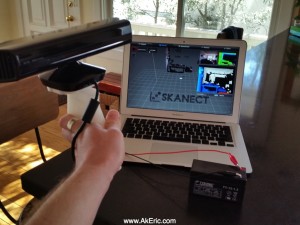Portable Kinect scanning
 I’d done a few experiments in the past with the Kinect / Skanect software (here, here). The biggest issue (other than my underpowered Macbook Air) was that you’re tied via the USB cables to both the computer, and the electrical socket in the wall: Hard to walk around things to scan them.
I’d done a few experiments in the past with the Kinect / Skanect software (here, here). The biggest issue (other than my underpowered Macbook Air) was that you’re tied via the USB cables to both the computer, and the electrical socket in the wall: Hard to walk around things to scan them.
After looking at the wall-wart for the Kinect, I saw that it works off 12v DC: Based on that, I picked up a small 12v Tysonic battery from Jameco, cut off the wall-wart, and soldered in some alligator clips to the power-cord. Now the Kinect clips directly to the battery (which fits in my pocket), allowing me to hold the Kinect in one hand (based on this sweet 3d-printed grip), my laptop in the other, for completely untethered scanning.
So while it is still way more clunky than an iSense/iPad combo, that battery only cost me $15, and I got the Kinect used for $50: A slightly lower price-point than a iSense/iPad purchase 😉
Hi! First off, great blog! Second, I’m considering doing this to my Kinect to make scanning portable. My one question is: is there an possibility of accidentally frying the Kinect if it’s directly connected to the battery? Because I have also been entertaining the idea of connecting a power inverter to a 12v battery then simply connecting the Kinect to the inverter.
Example of batteries to inverter: http://www.instructables.com/id/Portable-Battery-Powered-ACDC-Power-Source/?ALLSTEPS
Thanks!
Thanks for the compliment
I’m no expert on kinect frying, so if your hardware blows based on a direct connection to battery, don’t blame me 😉
Now that the disclaimer is out of the way however, I’ve ran mine for some time while scanning with no problem (the voltage is only going to drop after all), and I tackled this after reading online about others doing it without issue. I steered clear of the inverter simply because it’s even more hardware, and globally you’re loosing power during the conversion from DC to AC back to ultimately DC. But I’m sure it would work if you didn’t want to cut up your power cord.
My logic is: If the kinect draws 12v, and you give it 12v (actually slightly higher when the battery is fully charged), you should be good to go. And so far, so good. I think the kinect says that it draws around 1.2 amps (Trying to go off memory, don’t have it on me), but my guess that would only be when the little motors are running, which doesn’t happen when scanning. I should hook it up to my voltmeter and see what the draw actually is…